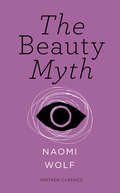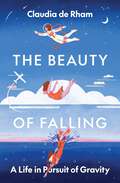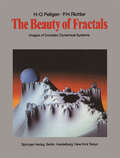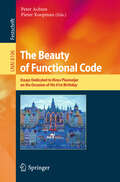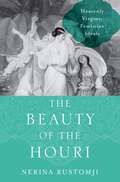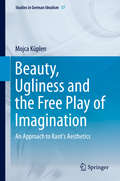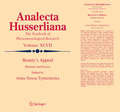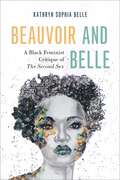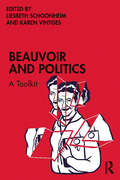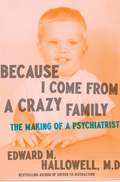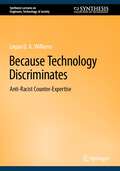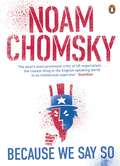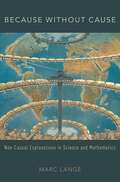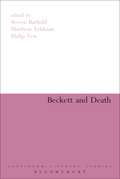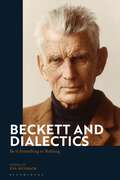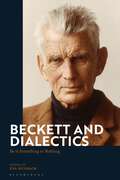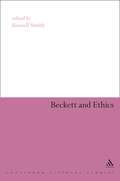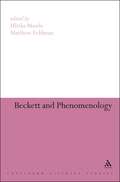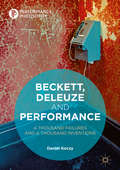- Table View
- List View
The Beauty Myth: How Images Of Beauty Are Used Against Women (Vintage Feminism Short Editions)
by Naomi WolfVintage Feminism: classic feminist texts in short formWITH A NEW INTRODUCTION BY THE AUTHOREvery day, women around the world are confronted with a dilemma – how to look. In a society embroiled in a cult of female beauty and youthfulness, pressure on women to conform physically is constant and all-pervading. In this shortened edition you will find the essence of Wolf’s groundbreaking book. It is a radical, gripping and frank exposé of the tyranny of the beauty myth, its oppressive function and the destructive obsession it engenders.
The Beauty of Falling: A Life in Pursuit of Gravity
by Claudia de RhamA world-renowned physicist seeks gravity&’s true nature and finds wisdom in embracing its force in her lifeClaudia de Rham has been playing with gravity her entire life. As a diver, experimenting with her body&’s buoyancy in the Indian Ocean. As a pilot, soaring over Canadian waterfalls on dark mornings before beginning her daily scientific research. As an astronaut candidate, dreaming of the experience of flying free from Earth&’s pull. And as a physicist, discovering new sides to gravity&’s irresistible personality by exploring the limits of Einstein&’s general theory of relativity. In The Beauty of Falling, de Rham shares captivating stories about her quest to gain intimacy with gravity, to understand both its feeling and fundamental nature. Her life&’s pursuit led her from a twist of fate that snatched away her dream of becoming an astronaut to an exhilarating breakthrough at the very frontiers of gravitational physics.While many of us presume to know gravity quite well, the brightest scientists in history have yet to fully answer the simple question: what exactly is gravity? De Rham reveals how great minds—from Newton and Einstein to Stephen Hawking, Andrea Ghez, and Roger Penrose—led her to the edge of knowledge about this fundamental force. She found hints of a hidden side to gravity at the particle level where Einstein&’s theory breaks down, leading her to develop a new theory of &“massive gravity.&” De Rham shares how her life&’s path turned from a precipitous fall to an exquisite flight toward the discovery of something entirely new about our surprising, gravity-driven universe.
The Beauty of Falling: A Life in Pursuit of Gravity
by Claudia de RhamA world-renowned physicist seeks gravity&’s true nature and finds wisdom in embracing its force in her lifeClaudia de Rham has been playing with gravity her entire life. As a diver, experimenting with her body&’s buoyancy in the Indian Ocean. As a pilot, soaring over Canadian waterfalls on dark mornings before beginning her daily scientific research. As an astronaut candidate, dreaming of the experience of flying free from Earth&’s pull. And as a physicist, discovering new sides to gravity&’s irresistible personality by exploring the limits of Einstein&’s general theory of relativity. In The Beauty of Falling, de Rham shares captivating stories about her quest to gain intimacy with gravity, to understand both its feeling and fundamental nature. Her life&’s pursuit led her from a twist of fate that snatched away her dream of becoming an astronaut to an exhilarating breakthrough at the very frontiers of gravitational physics.While many of us presume to know gravity quite well, the brightest scientists in history have yet to fully answer the simple question: what exactly is gravity? De Rham reveals how great minds—from Newton and Einstein to Stephen Hawking, Andrea Ghez, and Roger Penrose—led her to the edge of knowledge about this fundamental force. She found hints of a hidden side to gravity at the particle level where Einstein&’s theory breaks down, leading her to develop a new theory of &“massive gravity.&” De Rham shares how her life&’s path turned from a precipitous fall to an exquisite flight toward the discovery of something entirely new about our surprising, gravity-driven universe.
The Beauty of Fractals: Images of Complex Dynamical Systems
by Heinz-Otto Peitgen Peter H. RichterNow approaching its tenth year, this hugely successful book presents an unusual attempt to publicise the field of Complex Dynamics. The text was originally conceived as a supplemented catalogue to the exhibition "Frontiers of Chaos", seen in Europe and the United States, and describes the context and meaning of these fascinating images. A total of 184 illustrations - including 88 full-colour pictures of Julia sets - are suggestive of a coffee-table book.However, the invited contributions which round off the book lend the text the required formality. Benoit Mandelbrot gives a very personal account, in his idiosyncratic self-centred style, of his discovery of the fractals named after him and Adrien Douady explains the solved and unsolved problems relating to this amusingly complex set.
The Beauty of Functional Code: Essays Dedicated to Rinus Plasmeijer on the Occasion of His 61st Birthday (Lecture Notes in Computer Science #8106)
by Peter Achten Pieter KoopmanThis Festschrift has been published in honor of Rinus Plasmeijer, to celebrate the combined occasion of his 61st birthday and the 25th Symposium on Implementation and Application of Functional Languages, IFL 2013, held in Nijmegen, The Netherlands, in August 2013. Rinus Plasmeijer was the main designer of the lazy functional programming language "Clean" and has always been the leader of the associated research team. He has played a decisive role in making the Radboud University of Nijmegen an important center of research in functional programming by organizing and hosting the first few IFL symposia in Nijmegen. This Festschrift contains 19 scientific essays written by former PhD students of Rinus Plasmeijer and researchers in the field of functional programming who have collaborated with him. The authors write about the influence the beauty of functional programming has had or still has on their work.
The Beauty of the Houri: Heavenly Virgins, Feminine Ideals
by Nerina RustomjiA captivating look at the history of the pure females of Islamic paradise known as the houri The fascination with the houri, the pure female of Islamic paradise, began long before September 11, 2001. Beauty of the Houri: Heavenly Virgins, Feminine Ideals demonstrates how the ambiguous reward of the houri, mentioned in the Qur)qan and developed in Islamic theological writings, has gained a distinctive place in the cultural eye from the seventeenth to the twenty-first century. The houri had multiple functions in Islamic texts that ranged from caretaker, to pure companion, to personal entertainment. French, English, and American writers used the houri to critique Islam and Muslim societies, while also adopting the houri as a model of feminine beauty. Unlike earlier texts that presented different forms of the houri or universalized the houri for all women, writings about the houri after September 11th offer contradictory messages about Islam. In the twenty-first century, the image of the houri has come to symbolize a reward for violence and the possibility of gender parity. As a cosmic figure that inspires enduring questions about the promise of paradise and the idealized feminine form, the houri has a singular past and broad potential for future interpretation. The Beauty of the Houri narrates an intellectual history of the houri and offers a contemporary account of how theological ambiguity has led to different interpretations of this powerfully enduring Islamic concept.
The Beauty of the Houri: Heavenly Virgins, Feminine Ideals
by Nerina RustomjiA captivating look at the history of the pure females of Islamic paradise known as the houri The fascination with the houri, the pure female of Islamic paradise, began long before September 11, 2001. Beauty of the Houri: Heavenly Virgins, Feminine Ideals demonstrates how the ambiguous reward of the houri, mentioned in the Qur)qan and developed in Islamic theological writings, has gained a distinctive place in the cultural eye from the seventeenth to the twenty-first century. The houri had multiple functions in Islamic texts that ranged from caretaker, to pure companion, to personal entertainment. French, English, and American writers used the houri to critique Islam and Muslim societies, while also adopting the houri as a model of feminine beauty. Unlike earlier texts that presented different forms of the houri or universalized the houri for all women, writings about the houri after September 11th offer contradictory messages about Islam. In the twenty-first century, the image of the houri has come to symbolize a reward for violence and the possibility of gender parity. As a cosmic figure that inspires enduring questions about the promise of paradise and the idealized feminine form, the houri has a singular past and broad potential for future interpretation. The Beauty of the Houri narrates an intellectual history of the houri and offers a contemporary account of how theological ambiguity has led to different interpretations of this powerfully enduring Islamic concept.
Beauty, Ugliness and the Free Play of Imagination: An Approach to Kant's Aesthetics (Studies in German Idealism #17)
by Mojca KüplenThis book presents a solution to the problem known in philosophical aesthetics as the paradox of ugliness, namely, how an object that is displeasing can retain our attention and be greatly appreciated. It does this by exploring and refining the most sophisticated and thoroughly worked out theoretical framework of philosophical aesthetics, Kant’s theory of taste, which was put forward in part one of the Critique of the Power of Judgment. The book explores the possibility of incorporating ugliness, a negative aesthetic concept, into the overall Kantian aesthetic picture. It addresses a debate of the last two decades over whether Kant's aesthetics should allow for a pure aesthetic judgment of ugliness. The book critically reviews the main interpretations of Kant’s central notion of the free play of imagination and understanding and offers a new interpretation of free play, one that allows for the possibility of a disharmonious state of mind and ugliness.In addition, the book also applies an interpretation of ugliness in Kant’s aesthetics to resolve certain issues that have been raised in contemporary aesthetics, namely the possibility of appreciating artistic and natural ugliness and the role of disgust in artistic representation.Offering a theoretical and practical analysis of different kinds of negative aesthetic experiences, this book will help readers acquire a better understanding of his or her own evaluative processes, which may be helpful in coping with complex aesthetic experiences. Readers will gain unique insight into how ugliness can be offensive, yet, at the same time, fascinating, interesting and captivating.
Beauty's Appeal: Measure and Excess (Analecta Husserliana #97)
by Anna-Teresa TymienieckaBeauty fulfils human existence. As it registers in our aesthetic experience, beauty enhances nature’s enchantment around us and our inward experience lifting our soul toward moral elevation. This collection of art-explorations seeks the elemental ties of the Human Condition. It endeavors to explain the relation of beauty and human existence, and explores the various aspects of beauty.
Beauvoir and Belle: A Black Feminist Critique of The Second Sex (Philosophy of Race)
by Kathryn Sophia BelleKathryn Sophia Belle centers feminist frameworks, discourses, and vocabularies of Black women and other Women of Color that existed prior to and have continued to exist after The Second Sex. She centers and amplifies the voices of Black women and other Women of Color, such as Lorraine Hansberry, Angela Davis, Chikwenye Ogunyemi, Deborah King, Oy?r?nk? Oyw?m?, Mariana Ortega, Kathy Glass, bell hooks, Kyoo Lee, Stephanie Rivera Berruz, Patricia Hill Collins, and Alia Al-Saji. Special attention is also given to Claudia Jones and Audre Lorde, both of whom implicitly and indirectly engage with The Second Sex. Beauvoir and Belle demonstrates the myriad ways in which these frameworks both expose and surpass the limits of The Second Sex. Belle argues against the frameworks of oppression used by Simone de Beauvoir in The Second Sex, a foundational text of white feminist philosophy. She frames Beauvoir's analogies as limitations, and shows how Beauvoir either does not engage with Black women and other Women of Color-or engages with them in problematic ways. Belle explores how Black and other Women of Color have critically written and talked about The Second Sex, and in so doing exposes the ways in which the existing Beauvoir scholarship has mostly ignored these engagements, thereby replicating Beauvoir's exclusions.
Beauvoir and Belle: A Black Feminist Critique of The Second Sex (Philosophy of Race)
by Kathryn Sophia BelleKathryn Sophia Belle centers feminist frameworks, discourses, and vocabularies of Black women and other Women of Color that existed prior to and have continued to exist after The Second Sex. She centers and amplifies the voices of Black women and other Women of Color, such as Lorraine Hansberry, Angela Davis, Chikwenye Ogunyemi, Deborah King, Oy?r?nk? Oyw?m?, Mariana Ortega, Kathy Glass, bell hooks, Kyoo Lee, Stephanie Rivera Berruz, Patricia Hill Collins, and Alia Al-Saji. Special attention is also given to Claudia Jones and Audre Lorde, both of whom implicitly and indirectly engage with The Second Sex. Beauvoir and Belle demonstrates the myriad ways in which these frameworks both expose and surpass the limits of The Second Sex. Belle argues against the frameworks of oppression used by Simone de Beauvoir in The Second Sex, a foundational text of white feminist philosophy. She frames Beauvoir's analogies as limitations, and shows how Beauvoir either does not engage with Black women and other Women of Color-or engages with them in problematic ways. Belle explores how Black and other Women of Color have critically written and talked about The Second Sex, and in so doing exposes the ways in which the existing Beauvoir scholarship has mostly ignored these engagements, thereby replicating Beauvoir's exclusions.
Beauvoir and Politics: A Toolkit
by Liesbeth Schoonheim Karen VintgesApproaching Simone de Beauvoir’s feminism and social commentary as a resource to understand our current crises, Beauvoir and Politics: A Toolkit brings together established and emerging scholars to apply her insights to gender studies, political philosophy, decolonisation, intellectual history, age theory, and critical phenomenology. The essays in this collection start from key concepts in Beauvoir’s oeuvre and relate them to contemporary debates, asking how her notion of ambiguity speaks to lived experiences that have been highly politicized in recent years, such as pregnancy, old age, sexual violence, and the exposure of black and brown bodies to police violence; how myths inform our notions of collective, national identities, as well as notions of masculinity and femininity; and how she provides conceptual tools that help to theorize the various political strategies that are used to challenge gendered and racialized systems of oppression. These and other issues are central to this critical appraisal of Beauvoir’s legacy, demonstrating the contemporary relevance of her thought as it diagnoses the present and looks toward change for a better future. This book will be of great interest to undergraduate and postgraduate students looking to engage with the political content of Simone de Beauvoir’s work and the timely application of her ideas.
Beauvoir and Politics: A Toolkit
Approaching Simone de Beauvoir’s feminism and social commentary as a resource to understand our current crises, Beauvoir and Politics: A Toolkit brings together established and emerging scholars to apply her insights to gender studies, political philosophy, decolonisation, intellectual history, age theory, and critical phenomenology. The essays in this collection start from key concepts in Beauvoir’s oeuvre and relate them to contemporary debates, asking how her notion of ambiguity speaks to lived experiences that have been highly politicized in recent years, such as pregnancy, old age, sexual violence, and the exposure of black and brown bodies to police violence; how myths inform our notions of collective, national identities, as well as notions of masculinity and femininity; and how she provides conceptual tools that help to theorize the various political strategies that are used to challenge gendered and racialized systems of oppression. These and other issues are central to this critical appraisal of Beauvoir’s legacy, demonstrating the contemporary relevance of her thought as it diagnoses the present and looks toward change for a better future. This book will be of great interest to undergraduate and postgraduate students looking to engage with the political content of Simone de Beauvoir’s work and the timely application of her ideas.
Because I Come from a Crazy Family: The Making of a Psychiatrist
by Edward M. HallowellFrom the bestselling author of the classic book on ADD, Driven to Distraction, a memoir of the strange upbringing that shaped Dr. Edward M. Hallowell's celebrated career. When Edward M. Hallowell was eleven, a voice out of nowhere told him he should become a psychiatrist. A mental health professional of the time would have called this psychosis. But young Edward (Ned) took it in stride, despite not quite knowing what "psychiatrist" meant. With a psychotic father, alcoholic mother, abusive stepfather, and two so-called learning disabilities of his own, Ned was accustomed to unpredictable behavior from those around him, and to a mind he felt he couldn't always control. The voice turned out to be right. Now, decades later, Hallowell is a leading expert on attention disorders and the author of twenty books, including Driven to Distraction, the work that introduced ADD to the world. In Because I Come from a Crazy Family, he tells the often strange story of a childhood marked by what he calls the "WASP triad" of alcoholism, mental illness, and politeness, and explores the wild wish, surging beneath his incredible ambition, that he could have saved his own family of drunk, crazy, and well-intentioned eccentrics, and himself. Because I Come from a Crazy Family is an affecting, at times harrowing, ultimately moving memoir about crazy families and where they can lead, about being called to the mental health profession, and about the unending joys and challenges that come with helping people celebrate who they are.A portion of the author's proceeds of this book will go to NAMI (National Alliance on Mental Illness).
Because Technology Discriminates: Anti-Racist Counter-Expertise (Synthesis Lectures on Engineers, Technology, & Society #27)
by Logan D. WilliamsEngineers designing technologies and systems produce problems when they do not account for existing biases in society. Designers have a mandate to make technologies efficiently, economically, and ethically. This textbook is written for both students and practicing designers, engineers, researchers, or artists who want to create more ethical designs; it aims to help readers understand how race is implicated in technology design. Learning from historical and contemporary case studies of engineering and architecture projects will help readers see clearly the power of design decisions to either perpetuate or contest racism. Chapter exercises will change engineers’ mental models to see the bias inherent to existing technological design. By incorporating the knowledge and insights of community-based experts into design projects, readers will begin to practice anti-racist leadership and counter-expertise.
Because We Say So (City Lights Open Media Ser.)
by Noam ChomskyBecause We Say So is Noam Chomsky's essential counter punch to American hegemony.In 1962, the eminent statesman Dean Acheson enunciated a principle that has dominated global politics ever since: that no legal issue arises when the United States responds to a challenge to its 'power, position, and prestige'. In short, whatever the world may think, U.S. actions are legitimate because they say so. Spanning the impact of Edward Snowden's whistleblowing and Palestinian-Israeli relations to deeper reflections on political philosophy and the importance of a commons to democracy, Because We Say So takes American imperialism head on.'Noam Chomsky is one of a small band of individuals fighting a whole industry. And that makes him not only brilliant, but heroic' Arundhati Roy'The world's greatest public intellectual' Observer
Because Without Cause: Non-Casual Explanations In Science and Mathematics (Oxford Studies in Philosophy of Science)
by Marc LangeNot all scientific explanations work by describing causal connections between events or the world's overall causal structure. Some mathematical proofs explain why the theorems being proved hold. In this book, Marc Lange proposes philosophical accounts of many kinds of non-causal explanations in science and mathematics. These topics have been unjustly neglected in the philosophy of science and mathematics. One important kind of non-causal scientific explanation is termed explanation by constraint. These explanations work by providing information about what makes certain facts especially inevitable - more necessary than the ordinary laws of nature connecting causes to their effects. Facts explained in this way transcend the hurly-burly of cause and effect. Many physicists have regarded the laws of kinematics, the great conservation laws, the coordinate transformations, and the parallelogram of forces as having explanations by constraint. This book presents an original account of explanations by constraint, concentrating on a variety of examples from classical physics and special relativity. This book also offers original accounts of several other varieties of non-causal scientific explanation. Dimensional explanations work by showing how some law of nature arises merely from the dimensional relations among the quantities involved. Really statistical explanations include explanations that appeal to regression toward the mean and other canonical manifestations of chance. Lange provides an original account of what makes certain mathematical proofs but not others explain what they prove. Mathematical explanation connects to a host of other important mathematical ideas, including coincidences in mathematics, the significance of giving multiple proofs of the same result, and natural properties in mathematics. Introducing many examples drawn from actual science and mathematics, with extended discussions of examples from Lagrange, Desargues, Thomson, Sylvester, Maxwell, Rayleigh, Einstein, and Feynman, Because Without Cause's proposals and examples should set the agenda for future work on non-causal explanation.
Beckett and Death (Continuum Literary Studies #179)
by Steven Barfield Matthew Feldman Philip TewDeath is indisputably central to Beckett's writing and reception. This collection of research considers a number of Beckett's poems, novels, plays and short stories through considerations of mortality and death. Chapters explore the theme of deathliness in relation to Beckett's work as a whole, through three main approaches. The first of these situates Beckett's thinking about death in his own writing and reading processes, particularly with respect to manuscript drafts and letters. The second on the death of the subject in Beckett links dominant 'poststructural' readings of Beckett's writing to the textual challenge exemplified by the The Unnamable. A final approach explores psychology and death, with emphasis on deathly states like catatonia and Cotard's Syndrome that recur in Beckett's work. Beckett and Death offers a range of cutting-edge approaches to the trope of mortality, and a unique insight into the relationship of this theme to all aspects of Beckett's literature.
Beckett and Dialectics: Be it Something or Nothing
by Eva RudaFor a long time, analysis of the work of Samuel Beckett has been dominated by existentialist and post-structuralist interpretations. This new volume instead raises the question of how to understand Beckett via the dialectics underpinning his work. The different chapters explore how Beckett exposes and challenges essential dialectical concepts such as objectivity, subjectivity, exteriority, interiority, immanence, transcendence, and most crucially: negativity. With contributions from prominent scholars such as Alain Badiou, Mladen Dolar, and Rebecca Comay, Beckett and Dialectics not only sheds new light on how Beckett investigates the shapes, types, and forms of negation – as in the all-pervasive figures of 'nothing', 'no', 'null', and 'not' – but also examines how several phenomena that occur throughout Beckett's work are structured in their use of negativity. These include the relationships between voice and silence, space and void, movement and stasis, the finite and the infinite and repetition and transformation. This original analysis lends an important new perspective to Beckett studies, and even more fundamentally, to dialectics itself.
Beckett and Dialectics: Be it Something or Nothing
For a long time, analysis of the work of Samuel Beckett has been dominated by existentialist and post-structuralist interpretations. This new volume instead raises the question of how to understand Beckett via the dialectics underpinning his work. The different chapters explore how Beckett exposes and challenges essential dialectical concepts such as objectivity, subjectivity, exteriority, interiority, immanence, transcendence, and most crucially: negativity. With contributions from prominent scholars such as Alain Badiou, Mladen Dolar, and Rebecca Comay, Beckett and Dialectics not only sheds new light on how Beckett investigates the shapes, types, and forms of negation – as in the all-pervasive figures of 'nothing', 'no', 'null', and 'not' – but also examines how several phenomena that occur throughout Beckett's work are structured in their use of negativity. These include the relationships between voice and silence, space and void, movement and stasis, the finite and the infinite and repetition and transformation. This original analysis lends an important new perspective to Beckett studies, and even more fundamentally, to dialectics itself.
Beckett and Ethics (Continuum Literary Studies)
by Russell SmithAt first glance, Samuel Beckett's writing-where scenes of violence and cruelty often provide the occasion for an unremittingly bleak comedy-would seem to offer the reader few examples of ethical conduct. However, following the recent "ethical turn" in critical theory, there has been growing interest in the ethicality of Beckett's work. Following Alain Badiou's highly influential claim for Beckett as essentially an ethical thinker, it is time to ask: What is the relation between Beckett's work and the ethical? Is Beckett's work profoundly ethical in its implications, as both humanist and deconstructionist readings have insisted in their different ways? Or does Beckett's work in some way call into question the entire notion of the ethical? This provocative collection of essays seeks to map out this emerging debate in Beckett criticism. It will be a landmark contribution to an exciting new field, not only in Beckett Studies, but in literary studies and critical theory more broadly.
Beckett and Phenomenology (Continuum Literary Studies)
by Ulrika Maude Matthew FeldmanExistentialism and poststructuralism have provided the two main theoretical approaches to Samuel Beckett's work. These influential philosophical movements, however, owe a great debt to the phenomenological tradition. This volume, with contributions by major international scholars, examines the phenomenal in Beckett's literary worlds, comparing and contrasting his writing with key figures including Edmund Husserl, Martin Heidegger, Jean-Paul Sartre and Maurice Merleau-Ponty. It advances an analysis of hitherto unexplored phenomenological themes, such as nausea, immaturity and sleep, in Beckett's work. Through an exploration of specific thinkers and Beckett's own artistic method, it offers the first sustained and comprehensive account of Beckettian phenomenology.
Beckett and Phenomenology (Continuum Literary Studies #182)
by Ulrika Maude Matthew FeldmanExistentialism and poststructuralism have provided the two main theoretical approaches to Samuel Beckett's work. These influential philosophical movements, however, owe a great debt to the phenomenological tradition. This volume, with contributions by major international scholars, examines the phenomenal in Beckett's literary worlds, comparing and contrasting his writing with key figures including Edmund Husserl, Martin Heidegger, Jean-Paul Sartre and Maurice Merleau-Ponty. It advances an analysis of hitherto unexplored phenomenological themes, such as nausea, immaturity and sleep, in Beckett's work. Through an exploration of specific thinkers and Beckett's own artistic method, it offers the first sustained and comprehensive account of Beckettian phenomenology.
Beckett, Deleuze and Performance: A Thousand Failures and A Thousand Inventions (Performance Philosophy)
by Daniel KoczyThis book draws on the theatrical thinking of Samuel Beckett and the philosophy of Gilles Deleuze to propose a method for research undertaken at the borders of performance and philosophy. Exploring how Beckett fabricates encounters with the impossible and the unthinkable in performance, it asks how philosophy can approach what cannot be thought while honouring and preserving its alterity. Employing its method, it creates a series of encounters between aspects of Beckett’s theatrical practice and a range of concepts drawn from Deleuze’s philosophy. Through the force of these encounters, a new range of concepts is invented. These provide novel ways of thinking affect and the body in performance; the possibility of theatrical automation; and the importance of failure and invention in our attempts to respond to performance encounters. Further, this book includes new approaches to Beckett’s later theatrical work and provides an overview of Deleuze’s conception of philosophical practice as an ongoing struggle to think with immanence.
Beckett, Deleuze and Performance: A Thousand Failures and A Thousand Inventions (Performance Philosophy)
by Daniel KoczyThis book draws on the theatrical thinking of Samuel Beckett and the philosophy of Gilles Deleuze to propose a method for research undertaken at the borders of performance and philosophy. Exploring how Beckett fabricates encounters with the impossible and the unthinkable in performance, it asks how philosophy can approach what cannot be thought while honouring and preserving its alterity. Employing its method, it creates a series of encounters between aspects of Beckett’s theatrical practice and a range of concepts drawn from Deleuze’s philosophy. Through the force of these encounters, a new range of concepts is invented. These provide novel ways of thinking affect and the body in performance; the possibility of theatrical automation; and the importance of failure and invention in our attempts to respond to performance encounters. Further, this book includes new approaches to Beckett’s later theatrical work and provides an overview of Deleuze’s conception of philosophical practice as an ongoing struggle to think with immanence.
